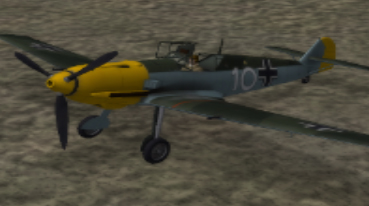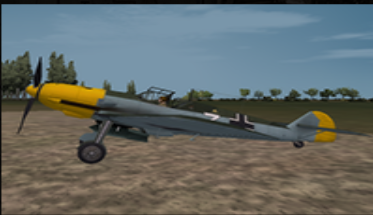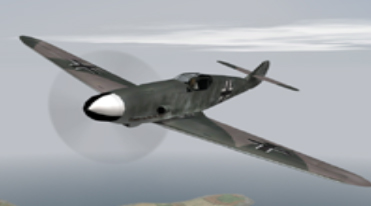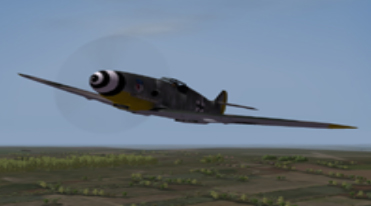Bf109
Messerschmitt Bf 109E-1
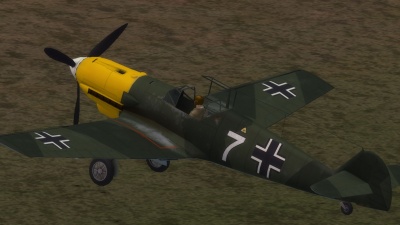
| |
| Messerschmitt Bf 109E-1 | |
| Specifications | |
| Type | Fighter |
| Armament | 4 x 7.9 mm Machine Guns |
| Crew | 1 (Pilot) |
| Weight | 2,573kg |
| Top Speed | 554km/h |
| Armored Glass Windscreen | ? |
| Pilot Armor (back/head) | ? |
History
Almost doomed by the bureaucracy of the RLM prior to its maiden flight, the Messerschmitt Bf 109 went on to become the most numerously produced German fighter of the war. Its design was simple; a compact slender airframe with plenty of power and a heavy gun package.
The Bf 109 combat lineage began with the Spanish Civil war when in October 1936 a handful of early Bf 109 prototypes were hastily sent as reinforcement to the embattled Nationalist air force. All in all some 140 Bf 109s of different variants were engaged in Spain between 1936 and 1939. Thus, by the outbreak of WWII the E model was a combat tested fighter aircraft of proven quality. Equally important, the 'field test' in Spain had given its pilots and leaders plenty of experience with this new generation of high-speed monoplane aircraft that led to development of new tactics and procedures that have held true through to this day.
The Bf 109 enjoyed a good turn of speed and a very high rate of climb as its most useful performance attributes, and good combat pilots learned how to employ this against opponents who could not climb as quickly. The 109 series had certain shortcomings, chief among them a very short operational range, a narrow and cramped cockpit and bad handling on bumpy grass airstrips due to the very narrow landing gear footprint.
The Bf 109E-1, first fielded in 1939, was the first variant to feature the excellent DB 601 engine. With four rifle-calibre machine guns it has the lightest firepower of all Bf 109 variants. This same lightness also makes it the most manoeuvrable of all variants, especially in turn radius. Though its weaponry carries less punch than later variants the E-1 machine guns are belted with incendiary ammunition and offer a high rate of fire that ultimately yields more destructive power than a cursory glance may lead to believe.
NOTE: the Bf = Me, as in Me-109. For a time Bayerische Flugzeugwerke (Bavarian Aircraft Works) was the name of the company, before it was reconstituted as Messerschmitt AG on July 11, 1938 (with Willy Messerschmitt as chairman and managing director). The renaming of BFW resulted in the company's RLM designation changing from Bf to Me. Existing types, such as the Bf 109 and 110, retained their earlier designation in official documents, although sometimes the newer designations were used as well. In practise, all BFW/Messerschmitt aircraft from 108 to 163 (not the same plane as the Me 163) were prefixed Bf, all later types with Me.
Game Play
The Bf 109E-1 is the "turningest" of all German fighters in the WWIIOL:BE inventory. Light, fast and nimble, this aircraft possesses all the traits vital to an air superiority fighter. It does almost everything better than the opposition in its tier: it is superior in climb, in level speed and in dive performance. These traits allows it to attain superior altitude with which it can dominate any contender, and to engage and disengage at will - features a true energy fighter will appreciate.
The E-1 can hold its own in a turning fight as well: it rolls well, its initial and sustained rate of turn is superlative and it can go toe to toe with any enemy fighter in its tier. While the E-1 may not be able to out-turn a Hurricane or a H-75 in a prolonged stall fight on the deck, it can easily dominate these opponents by operating in the vertical.
Although lacking cannons, its four machine guns pack a considerable punch: a high rate of fire, a high muzzle velocity, and a plentiful allowance of hard-hitting incendiary ammunition is more than sufficient to down any target - though you will need to fly close to your man and fire a concentrated volley.
The Bf 109E-1 sports, or lacks, one other conspicious feature: it has no armour plate behind the pilot's head (though the seat itself is armoured). This gives the pilot an unrestricted view aft at the price of a more vulnerable head. A clear view gives the pilot better situational awareness, a feature that is incomparably more valuable than any piece of armour.
The pilot who masters the Bf 109E-1 will eventually notice how much it has in common with the E-4 variant, and appreciate it for its clean and unladen character - the E-1 is a true hot rod, but as such, it demands discipline of its operator to give its best.
Messerschmitt Bf 109E-4
History
Deployed in quantity during the spring of 1940, the Bf 109E-4 variant was a significant upgrade over the original Emils. The original DB 601A-1 powerplant was replaced by the more powerful DB 601Aa, and firepower was vastly improved in weight of fire and destructive potential as each wing now packed one 20 mm MG-FF/M cannon.
Game Play
The Bf 109E-4 variant is fast and carries the heaviest armament of the Bf 109 series until the later G variant is introduced, with two 20mm cannon in the wings. However, with but 60 rounds per gun it pays to get close and only fire when certain to score a hit. Light and nimble and possessing of excellent dive characteristics, the Bf 109E-4 can mix it up in circling combats as well as stick to fast diving attacks. The Emil can be effective against any enemy type using coordinated wingman tactics, but when fighting without such support the pilot must rely on its speed and climb rate to survive an encounter against bad odds. Combine its overall good performance with a cool headed and confident pilot and the E can hold its own through an entire campaign. In the early stages of a WWIOL:BE campaign the Bf 109E does well to avoid typical protracted dogfights as all Allied aircraft can out turn the Bf 109E-4 with relative ease. Climbing, spiralling turns with but a small initial energy advantage, followed by slashing high-speed attacks, is the Bf 109E's forte. As the campaign progresses the Bf 109E-4 loses its speed advantage but gains in turn radius, requiring (and allowing) the pilot to rethink his approach to air combat.
While it is difficult for many players to grasp the advantages of a climbing turn style of combat, where the ability to bleed your opponent's energy to the point of stall while you remain above them awaiting the moment to drop on their head like a sledge hammer, it remains one of the most effective forms of air superiority combat tactics you can learn and master.
Another tactic that works well in the 109E is the scissors style where a series of slicing reversals one after another will force a pursuing fighter with a better turn rate (but less roll rate) out in front of your guns. Again, this is a difficult style of combat to learn but extremely effective if you ever do manage to learn how to master such a method.
Messerschmitt Bf 109E-4B
History
The standard Luftwaffe fighter-interceptor the ME1904EF was fitted with a centreline bomb rack in the Sumner of 1940 in order to keep the bombing attack against England going where other bomb-carriers failed. One Staffel (Squadron) per Gruppe (Wing) was typically designated as the Jagdbomber (Jabo) staffel, and sent out to attack airfields, pots and targets of opportunity. This practice was continued on all fronts until the very end, albeit with new and upgraded aircraft.
Game Play
The E-4 Jabo handles sornewhat more sluggishly while carrying its center-line Sprengbombe Cylindrisch 250 (SC250), but once shot of its cargo the fighter-bomber is as capable as the standard unladen Bf 109 E-4. It is verily the best of all worlds - it can bomb and fight like there is no tomorrow! Thus, in all respects except when lugging cargo, the E-4 Jabo does most things pretty well and some things better than its contemporary opponents. It dives well, climbs well, turns well and carries a good punch - just do not engage in prolonged max-rating turning combat at ground level.
Messerschmitt Bf 109F-2
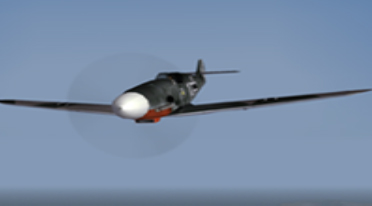
| |
| Messerschmitt Bf 109F-2 | |
| Specifications | |
| Type | Fighter |
| Armament | 1 x 20 mm Cannon, 2 x 7.9 mm Machine Guns |
| Crew | 1 (Pilot) |
| Weight | ?kg |
| Top Speed | ?km/h |
| Armored Glass Windscreen | ? |
| Pilot Armor (back/head) | ? |
History
The Me-109F-2 version of “Franz,” as its pilots called it, the F-2 received the 1,175 PS (1,159 hp, 864 kW) DB 601N engine driving a VDM 9-11207 propeller and replaced the MG FF with a higher velocity 15mm MG 151 cannon. As the harder-hitting 20 mm Mauser MG 151/20 version become available, a number of F-2s were retrofitted with it in the field. About 1,230 F-2s were built between October 1940 and August 1941 by AGO, Arado, Erla, Messerschmitt Regensburg and WNF(Wiener Neustädter Flugzeugwerke)
Game Play
he Bf 109F is a favorite fighter for those that cherish climbrate and know how to use both it and speed to create good shooting solutions, rather than just to set off and run at the first sign of trouble. For their opponents however it remains that the “run away” element of speed being a chief performance attribute is all they ever see or all that most ever *seem* to be able to see. For it’s time the Bf 109F is the fastest and the best climbing fighter available in Battleground Europe.
Messerschmitt Bf 109F-4
History
Considered by many to be the ultimate expression of the 109 line, the Bf 109F was an improved model over the 109E in almost all respects. It boasted a higher climb rate and top speed, in addition to the new MG151/20 high velocity 20mm cannon mounted to fire through the nose spinner.
While its armament was reduced in terms of mounted cannons (only 1 in place of the previous 2) the 20mm nose cannon was the superior MG151/20 now replacing the earlier aircrafts older style Mauser MGFF cannons. The firing duration was also greatly increased by both a far larger ammunition loadout of 200 rounds and only 1 cannon to expend them from.
In addition to this the centerline mounting gave no convergence issues and favoured accurate shooters. The downside was that combat reports tended to claim that for average or less accurate shooters it was more difficult to down enemy fighters with the centerline cannon than had previously been noted with the earlier wing mounted cannons of the 109E.
Game Play
The Bf 109F is a favorite fighter for those that cherish climbrate and know how to use both it and speed to create good shooting solutions, rather than just to set off and run at the first sign of trouble. For their opponents however it remains that the “run away” element of speed being a chief performance attribute is all they ever see or all that most ever *seem* to be able to see. For it’s time the Bf 109F is the fastest and the best climbing fighter available in Battleground Europe.
Up close and with a good gunner on the trigger, the more powerful MG151 (over the MGFF of the 109E) can rip any aircraft apart, but at longer ranges and higher deflection the rounds drop fast and disperse more wildly. The “Franz” is a fighter for true “experten” pilots, it will reward the studied and practiced pilot who employs skill and training in his fighting at all times, while at the same time it will quickly betray any over confidence and foolhardiness. Get in close, and when you think you are close enough, drive in closer still, then fire.
The Franz will turn competitively with Allied fighters, and with some creative flap usage it can even out turn some of them, but it remains true that to rely on turning alone is a bad choice in a plane that employs speed and climb to better advantage than it can its turn rate. It doesn’t turn well enough to let you rely on that aspect of air to air combat, and unless you are extremely confident in your ability you will die a lot trying to use the 109F as a pure turnfighter. The golden egg in this plane is its power to weight ratio and low drag. These combine to give it exemplary climb performance at any altitude. Indeed when all your cards are played out, a tight spiral climb can leave almost all opponents stalling below you, so remember that your exit in the Franz is always above you. So to is the best attack approach you can ever employ.
Messerschmitt Bf 109G-6/U4
History
The Bf-109G was an improved model over the Bf-109F in some respects, but not in others. It boasted a high climb rate and top speed, but it was no faster than the F in its earlier versions without MW50 injection. And its extra weight meant it didn't climb quite as well, although it still outclimbed the Allied aircraft, except for the Spitfire IX. The biggest surprise for those caught in its gun sights is going to be the "melon launcher" 30 mm Mk 108 cannon firing HE Mine rounds. This hits with roughly the same authority as a 40 mm Bofors round! However, the increased weight does hurt its turn performance over the lighter, more nimble 109F. The upside of this is that it's actually a little more stable in violent manuevering as a result of the loss of all that edgy nimbleness in its leaner sister. Those who can't handle the feeling of instability in the 109F may find the heavier G more to their liking.
Game Play
| Air Units in Battleground Europe | |
|---|---|
| Fighters and fighter bombers | |
| Bf 109E-1 | Bf 109E-4| Bf 109E-4B |Bf 109F-2 | Bf 109F-4 | Bf 109G-2/R1| Bf 109G-6/U4 | Bf 110C-4 | Bf 110C-4/B | Blenheim IF | Dewoitine D.520 | Fw 190A-3B | Fw 190A-4 | Hawk 75 | Hawk 81 | Hawk 87 | P-40F Kittyhawk Fighter Bomber | | Hurricane Mk I | Hurricane Mk IIb | Hurricane Mk IIc | Hurricane Mk IID | Junkers 87G2 'Stuka' | P-38 'Lightning' | Bell Model 14a / P-400 Airacobra | Model 26 / P-39N Airacobra | Spitfire Mk Ia | Spitfire Mk IIb | Spitfire Mk Vb | Spitfire Mk IXc | |
| Bombers | |
| Blenheim IV | Douglas DB-7 | Havoc Mk.I | A20C Havoc | Heinkel 111 | Junkers Ju 88A4 | Junkers 87 'Stuka' | | |
| Transport | |
| C47 'Skytrain' | Junkers 52 | |
